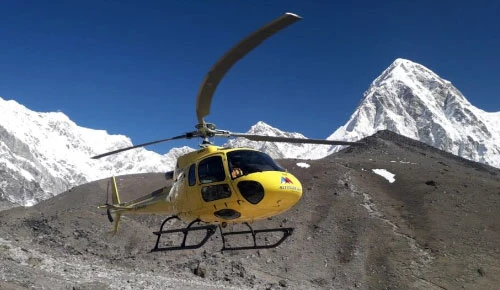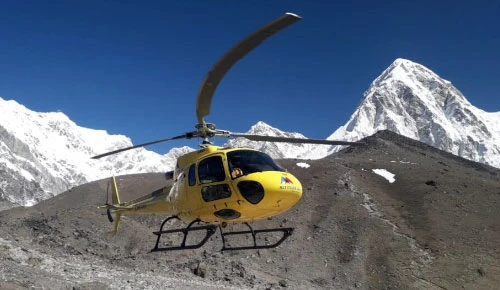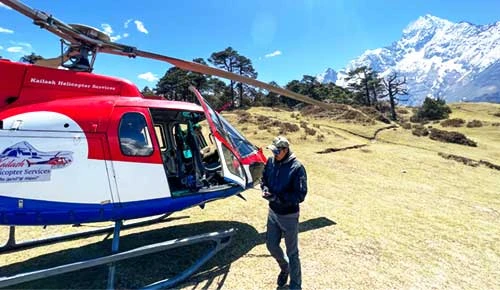History of Lukla Airport with Interesting Facts
Lukla Airport, also known as Tenzing-Hillary Airport, is a domestic airport and altiport in the town of Lukla, in Khumbu Pasang Lhamu, Solukhumbu District, Koshi Province of Nepal. It is located at an elevation of 9,337 feet (2,846 m) and is considered the gateway to Mount Everest.
The airport has a short runway of only 1,729 feet (527 m), which is one of the shortest runways in the world for commercial flights. The runway is also inclined at 12%, which makes landing even more challenging.
The airport is surrounded by mountains on all sides, which can create turbulence and make landing even more difficult. It is one of the most unique airport experiences in the world. The weather in the region can also be unpredictable, with fog and clouds often obscuring the runway. Lukla is a world-famous airport and an immovable contributor to the popularity of the Everest Base Camp Trek.
Table of Contents
History of Lukla Airport
Lukla Airport was built in 1964 with the help of Sir Edmund Hillary, the first person to summit Mount Everest. Hillary was inspired to build the airport after seeing how difficult and dangerous it was for trekkers and climbers to reach the Everest region.
Before the airport was built, trekkers had to hike for several days from Kathmandu to reach the Everest region. This was a challenging and dangerous trek, especially during the monsoon season.

The construction of Lukla Airport was a major undertaking. It was necessary to carve the runway out of the side of a mountain and transport the airport's supplies by mule.
The airport was officially opened in 1964, and it quickly became the gateway to the Khumbu region. The airport has played a major role in the development of tourism in the region, and it has helped to make the trek to Eveerest base camp one of the most popular treks in the world.
Top 10 Intresting Facts about Lukla Airport
- Lukla Airport is known as one of the world's most dangerous airports.
- It is the primary entry point for trekkers and climbers heading to the region.
- The airport provides spectacular mountain views of the Himalayas.
- It is situated at a high altitude of 9,337 ft / 2,846 m.
- The airport's short and sloped runway requires skilled pilots.
- It plays a critical role in supporting Everest expeditions.
- Facilities at the airport are basic and limited.
- Flights can be frequently affected by unpredictable weather.
- Local communities collaborate to maintain safety standards.
- Lukla Airport is a bustling tourist hub during the trekking season.
What makes Lukla Airport so dangerous?
Most commercial airports have runways that are at least 5,000 feet long but the runway at Lukla Airport is only 1,729 feet. so, it's not the general airports you see. Lukla Airport is located in a narrow valley with a short runway. This makes it difficult for pilots to land and take off.
Lukla Airport is located at an elevation of 9,337 feet (2,846 m). This high elevation makes it difficult for aircraft to generate enough lift to take off and land. This is because the air is thinner at higher altitudes, which reduces the amount of lift that the wings of an aircraft can generate. Pilots have to compensate for the high elevation by using more power and flying at a higher angle of attack.
In addition, the weather conditions in the Everest region can be unpredictable. This can make it difficult for pilots to land and take off safely.
How was the Everest trek before the start of Lukla Airport?
Before the construction of Lukla Airport, the Everest Base Camp trek was a much more challenging and dangerous one. Trekkers had to hike for several days from Kathmandu to reach the Everest region, and the trail was often in poor condition. Trekkers used to trek from Jiri to Everest Base Camp which is also known as the traditional or classic Everest base camp route.

The trek was also more expensive, as trekkers had to pay porters to carry their gear. The porters were often overloaded, putting them at risk of developing altitude sickness.
The trek was also less popular before the construction of Lukla Airport. This was because it was more challenging and expensive, and it took longer to complete.
How did the trekking initially start?
Climbers who were attempting to summit Mount Everest started the Everest Base Camp trek first. These climbers needed to acclimatize to the high altitude before they could make their summit attempt. As a result, they would frequently hike to base camp and stay there for several weeks.
Over time, the trek also gained popularity among trekkers who were interested in experiencing the Everest region without aiming to summit the mountain. This trek provides stunning views of Mount Everest and the other mountains in the area, making it an excellent way to learn about the Sherpa culture.
Was the trek famous before Lukla Airport?
Trekking in Sagarmatha National Park was not as famous before the construction of Lukla Airport. This was because it was more challenging, expensive, and took longer to complete. As per the data, less than 100 people would visit the region before the airport was established.
The trek became more popular after the airport was built, as it became easier and cheaper to reach the Everest region.
What was the impact of tourism in the Everest region after Lukla Airport?
The construction of Lukla Airport had a major impact on tourism in the region. The airport made it easier and cheaper for tourists to reach the region, and this led to a significant increase in the number of tourists visiting the Everest Base Camp.
The increase in tourism has had a positive impact on the local economy. The tourists provide jobs for many people in the region, and they help to bring in money that is used to develop the region.
The impact can be clearly seen in the numbers:
Year | Number of Trekkers in Sagarmatha National Park |
1964 (year Lukla Airport was built) | 40 |
1975 | 2,000 |
1985 | 10,000 |
1995 | 25,000 |
2005 | 40,000 |
2015 | 50,000 |
2021-22 (covid year) | 26,235 |
Significance of Lukla Airport on EBC Trek
According to a study published in the journal "High Altitude Medicine & Biology," the death rate on the Everest region trek has decreased by 50% since the construction of Lukla Airport. The study found that the main reason for the decrease is the improved accessibility to emergency evacuation.
Lukla Airport is the gateway to the region. It is the only way to get to the region by air. This has made the trek more accessible to trekkers from all over the world.
Lukla Airport has improved the safety of the trek. Before, it was a challenging and dangerous trek, especially during the monsoon season. The airport has reduced the risk of accidents and injuries.
Lukla Airport has made it possible to bring medical supplies and personnel to the region.
Getway of several other trekking routes on Everest Region
Lukla Airport holds immense importance for several trek routes in the Everest region, including:
1. Gokyo Chola Pass Trekking with EBC
- Lukla Airport acts as the starting point, enabling trekkers to commence their journey swiftly.
- Convenient access allows trekkers to explore the Gokyo Lakes, Chola Pass, and the surrounding breathtaking landscapes efficiently.
- Lukla Airport serves as the primary gateway for trekkers embarking on the Circuit Trek.
- Trekkers can easily access the diverse terrains and cultural gems of the Everest region, including the iconic Everest Base Camp.
- The trek commences from Lukla, providing a seamless way for trekkers to reach the mesmerizing Gokyo Valley and its turquoise lakes.
- Lukla Airport's proximity ensures trekkers can immerse themselves in the natural beauty and tranquility of Gokyo Lake without unnecessary travel hassles.
- Lukla Airport plays a pivotal role in the Three Passes Trek, one of the most challenging and rewarding treks in the region.
- Trekkers can efficiently navigate the high mountain passes—Renjo La, Cho La, and Kongma La—due to the accessibility provided by Lukla Airport.
Lukla Airport's strategic location is instrumental in facilitating these popular Everest region treks. Its proximity ensures trekkers can make the most of their adventure, exploring diverse landscapes, experiencing local culture, and conquering high mountain passes without delays, making the airport a vital hub for trekkers from around the world.
Conclusion
In summary, Lukla Airport, also known as Tenzing-Hillary Airport, has been a game-changer for the EBC trek. Before its construction in 1964, the trek was challenging, expensive, and risky. Trekkers had to hike for days from Kathmandu, hire porters, and endure unpredictable weather.
The airport's significance lies in its unique and challenging characteristics, including one of the world's shortest runways. It has become the gateway to the Everest region, making the trek more accessible and safer.
Since Lukla Airport's establishment, tourism in the region has flourished, bringing numerous tourists and providing a boost to the local economy. Notably, the airport has reduced the death rate on the trek by 50%, primarily due to improved emergency evacuation options.
In essence, Lukla Airport has transformed the region's trek into a global adventure, offering an accessible and safer journey to the base camp of the world's tallest mountain.








